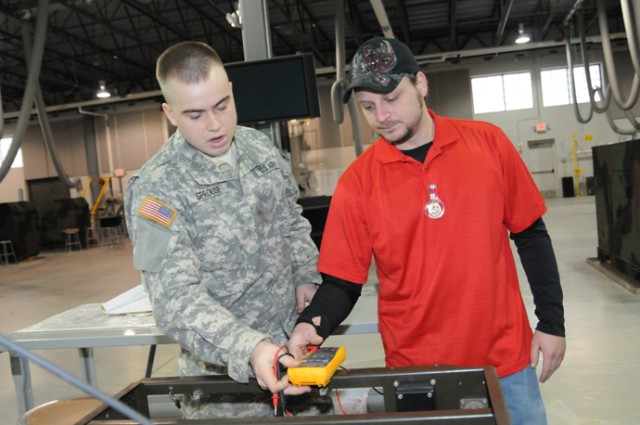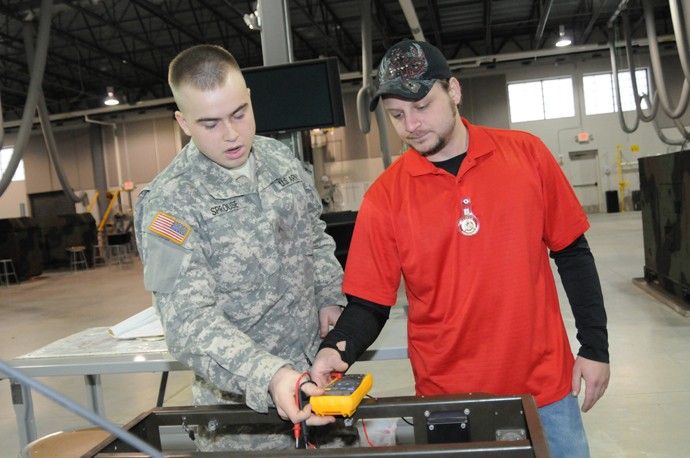FORT LEE, Va. (Jan. 13, 2011) -- Today's dynamic operational environment demands a more versatile maintenance Soldier, one who has the skills to repair and maintain an ever-changing inventory of equipment.
Skills-Based Training, a new initiative that targets initial entry Soldiers, is designed to meet those needs. It is an outcome-based approach to learning that emphasizes adaptable skills - those that will enable Soldiers to effectively accomplish more through critical thinking. Its feasibility is the subject of current analysis in the power generation equipment repairer (91D) course taught at the Ordnance School.
Juan M. Davila, senior training specialist, Ordnance Training Division, Combined Arms Support Command, said Skills-Based Training methods are being taught to advanced individual training students in two classes currently in session at the school. He said the concept seeks to improve training on two fronts.
"What we are changing, specifically at skill-level one (E-4s and below), is how we deliver the training to the student," he said. The second thing we're changing is the content."
On the delivery front, instructors dominate classroom time, using PowerPoint presentations and conferences as the primary methods to distribute information.
"We demonstrate a lot by using visual aids in the classroom versus spending more time with the equipment in itself," said Davila.
SBT will focus on the student and his ability to capture the information.
"Instead of having the instructors deliver all the information, we're going to make the students critical thinkers," said Davila. "We will question and inquire of the students. That's how they will learn. We want them to work for the information. They will, in turn, be our new training tool."
Using diagnostics and teaching foundational concepts are the biggest changes in the course's content. Rather than teaching students about every model of generator, instructors can teach basic concepts that apply to all models, saving time and eliminating redundancy. Diagnostics will be used as a tool to support the new approach.
"We want students to know how to replace parts, but also we want them to know what their course of action is going to be prior to replacing them," said Davila. "How did you get up to that point' What thoughts did you use to arrive to that conclusion'" As course content, diagnostics are currently taught at skill level three (E-6).
"We're bringing it down," said Davila, "because the Ordnance Corps doctrine has changed. It went from a four-level maintenance program to a two-level maintenance program," meaning lower-ranked Soldiers take on responsibilities previously meant for noncommissioned officers.
"It is imperative for 91Ds to go out there now and repair (generators) and replace (parts) on site," said Davila, citing current field demands. "We can no longer afford to evacuate systems to the rear and have Soldiers work on them. We want Soldiers (who) can repair problems on site."
The SBT pilot program looks promising, said Benjamin Byrge, course and former 91D. He cited portions of the course in which Soldiers must find and resolve "bugs" or faults in working generators. "We're giving them the opportunity to think about how a circuit works and what components are actually working," he said. "Before, they were just troubleshooting wire-to-wire. It gets rid of a lot of repetition."
The diagnostic approach to teaching not only empowers the student, said Byrge, but it also supports a knowledge foundation that allows him or her to tackle a more varied array of maintenance and repair issues.
"We currently have five different generator sets," said Byrge. "We give them the circuit on one set, give them the major components, and they figure the circuits out on the other generator sets on their own with minimal guidance from the instructors. They actually get a better understanding of how things are working and how (the system) works."
Davila, also a former 91D, said the results of the pilot program will reveal whether SBT is a viable replacement to the way the course is currently taught.
"I think it is a good program from the standpoint of saving resources," he said, noting the results of the pilot will determine whether students are better prepared to accomplish their missions. "Our goal is to get capable Soldiers to their units as soon as possible, and I think this might be an efficient way of doing it."
The 91D pilot is scheduled to conclude sometime within the next eight months. Davila said the results will be packaged and sent to the Ordnance School commanding general for review.
"We will present the results in a decision brief," he said, "letting him know whether SBT is feasible for that military occupational specialty. If he sees fit to approve the changes, we'll implement them permanently."
SBT is a U.S. Army Training and Doctrine Command initiative and is being considered for MOSs Army-wide including others in the ordnance career field


Social Sharing